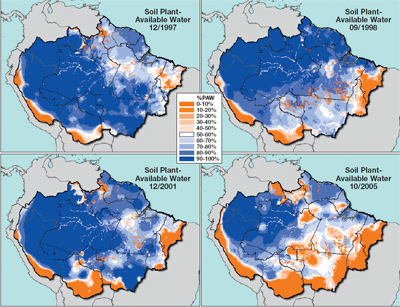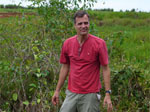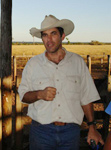Global warming accelerates destruction of the Amazon
Global warming accelerates destruction of the Amazon
mongabay.com
December 6, 2007
Deforestation and climate change could damage or destroy as much as 60 percent of the Amazon rainforest by 2030, according to a new report from environmental group WWF.
The report, The Amazon’s Vicious Cycles: Drought and Fire in the Greenhouse, shows that degradation in the Amazon could release 55-97 million tons of carbon dioxide by 2030. Forest loss could also dramatically impact water cycles in the region, affecting rainfall that is critical for river flows and agriculture.
“The importance of the Amazon forest for the globe’s climate cannot be underplayed,” said Dan Nepstad, Senior Scientist at the Woods Hole Research Center and author of the report. “It’s not only essential for cooling the world’s temperature but also such a large source of freshwater that it may be enough to influence some of the great ocean currents, and on top of that it’s a massive store of carbon.”
 Drought risk increasing in the Amazon Map of soil moisture levels across the Amazon during four dates of severe drought. This map is an estimation of the percentage of maximum, plant-available soil water (PAW) to 10m depth based on cumulative monthly rainfall and evapotranspiration, updated from Nepstad et al. 2004. Field studies indicate that drought-induced tree mortality begins when PAW declines to 30 per cent of its maximum value (Nepstad et al. 2007), mapped here as tan to brown. Soil moisture depletion is overestimated along the Andes because of data shortages and interpolation errors. |
The report says that climate change could diminish rainfall in the eastern Amazon by more than 20 percent while causing temperatures to climb by more than 2 ° C — and possibly by as much as 8 ° C — by the end of the century.
The changes in the Amazon could affect weather regimes as far away as Texas, according to NASA research. Nepstad agrees.
“The Amazon forest complex is intimately connected to the world’s climate. First, it influences climate by acting as a giant consumer of heat close to the ground, absorbing half of the solar energy that reaches it through the evaporation of water from its leaves,” he writes. “Second, it is a large, fairly sensitive reservoir
of carbon that is leaking into the atmosphere through deforestation, drought, and fire, contributing to the build up of atmospheric heat-trapping gases that are the cause of global warming. Third, the water that drains from these forests and into the Atlantic Ocean is 15-20 per cent of the world’s total river discharge, and may be enough to influence some of the great ocean currents that are, themselves, important regulators of the global climate system.”
“Amazon forest conservation will be necessary to stabilize the world’s climate,” he continues. “Stabilization of the world’s climate will be necessary
to conserve Amazon forests.”
In order to “stabilize” the Amazon to prevent large-scale die-backs and replacement of tropical forest by savanna, Nepstad says that measures to slow Amazon forest loss should include reducing the impact of cattle ranching, agricultural expansion, and infrastructure projects, while increasing the size of protected areas. Nepstad strongly believes that policy mechanisms to compensate tropical countries for the carbon contained in forests could be one of the best ways to promote forest conservation. Such policies are currently under discussion at the UN climate meeting in Bali.
Related articles
Amazon deforestation could be reduced to zero at $3 carbon price. The Amazon rainforest could play a major part in reducing greenhouse gas emissions that result from deforestation, reports a new study published by scientists at the Woods Hole Research Center, the Instituto de Pesquisa Ambiental da Amazonia, and the Universidade Federal de Minas Gerais. At a carbon price of $3 per ton, protecting the Amazon for its carbon value could outweigh the opportunity costs of forgoing logging, cattle ranching, and soy expansion in the region. 2008 certified emission-reduction credits for carbon currently trade at more than $90 per ton ($25 per ton of CO2).
 |
Globalization could save the Amazon rainforest
(6/3/2007) The Amazon basin is home to the world’s largest rainforest, an ecosystem that supports perhaps 30 percent of the world’s terrestrial species, stores vast amounts of carbon, and exerts considerable influence on global weather patterns and climate. Few would dispute that it is one of the planet’s most important landscapes. Despite its scale, the Amazon is also one of the fastest changing ecosystems, largely as a result of human activities, including deforestation, forest fires, and, increasingly, climate change. Few people understand these impacts better than Dr. Daniel Nepstad, one of the world’s foremost experts on the Amazon rainforest. Now head of the Woods Hole Research Center’s Amazon program in Belem, Brazil, Nepstad has spent more than 23 years in the Amazon, studying subjects ranging from forest fires and forest management policy to sustainable development. Nepstad says the Amazon is presently at a point unlike any he’s ever seen, one where there are unparalleled risks and opportunities. While he’s hopeful about some of the trends, he knows the Amazon faces difficult and immediate challenges.
Could the carbon market save the Amazon rainforest?
(11/29/2007) The global carbon market could play a key role in saving the Amazon from the effects of climate change and economic development, which could otherwise trigger dramatic ecological changes, reports a new paper published in Science. The authors argue that a well-articulated plan, financed by carbon markets, could prevent the worst outcomes for the Amazon forest while generating economic benefits for the region’s inhabitants.
Is the Amazon more valuable for carbon offsets than cattle or soy?
(10/17/2007) After a steep drop in deforestation rates since 2004, widespread fires in the Brazilian Amazon (September and October 2007) suggest that forest clearing may increase this year. All told, since 2000 Brazil has lost more than 60,000 square miles (150,000 square kilometers) of rainforest — an area larger than the state of Georgia or the country of Bangladesh. Most of this destruction has been driven by clearing for cattle pasture and agriculture, often in association with infrastructure development and improvements. Higher commodity prices, especially for beef and soy, have further spurred forest conversion in the region. While drivers of Amazon deforestation are stronger than ever, mounting concerns over climate change and the effort to reign in greenhouse gas emissions may provide new economic incentives for landowners to preserve forest lands through a concept known as “avoided deforestation”.
 |
Can cattle ranchers and soy farmers save the Amazon?
(6/6/2007) John Cain Carter, a Texas rancher who moved to the heart of the Amazon 11 years ago and founded what is perhaps the most innovative organization working in the Amazon, Alianca da Terra, believes the only way to save the Amazon is through the market. Carter says that by giving producers incentives to reduce their impact on the forest, the market can succeed where conservation efforts have failed. What is most remarkable about Alianca’s system is that it has the potential to be applied to any commodity anywhere in the world. That means palm oil in Borneo could be certified just as easily as sugar cane in Brazil or sheep in New Zealand. By addressing the supply chain, tracing agricultural products back to the specific fields where they were produced, the system offers perhaps the best market-based solution to combating deforestation. Combining these approaches with large-scale land conservation and scientific research offers what may be the best hope for saving the Amazon.
 |
Subtle threats could ruin the Amazon rainforest
(11/7/2007) While the mention of Amazon destruction usually conjures up images of vast stretches of felled and burned rainforest trees, cattle ranches, and vast soybean farms, some of the biggest threats to the Amazon rainforest are barely perceptible from above. Selective logging — which opens up the forest canopy and allows winds and sunlight to dry leaf litter on the forest floor — and 6-inch high “surface” fires are turning parts of the Amazon into a tinderbox, putting the world’s largest rainforest at risk of ever-more severe forest fires. At the same time, market-driven hunting is impoverishing some areas of seed dispersers and predators, making it more difficult for forests to recover. Climate change — an its forecast impacts on the Amazon basin — further looms large over the horizon.